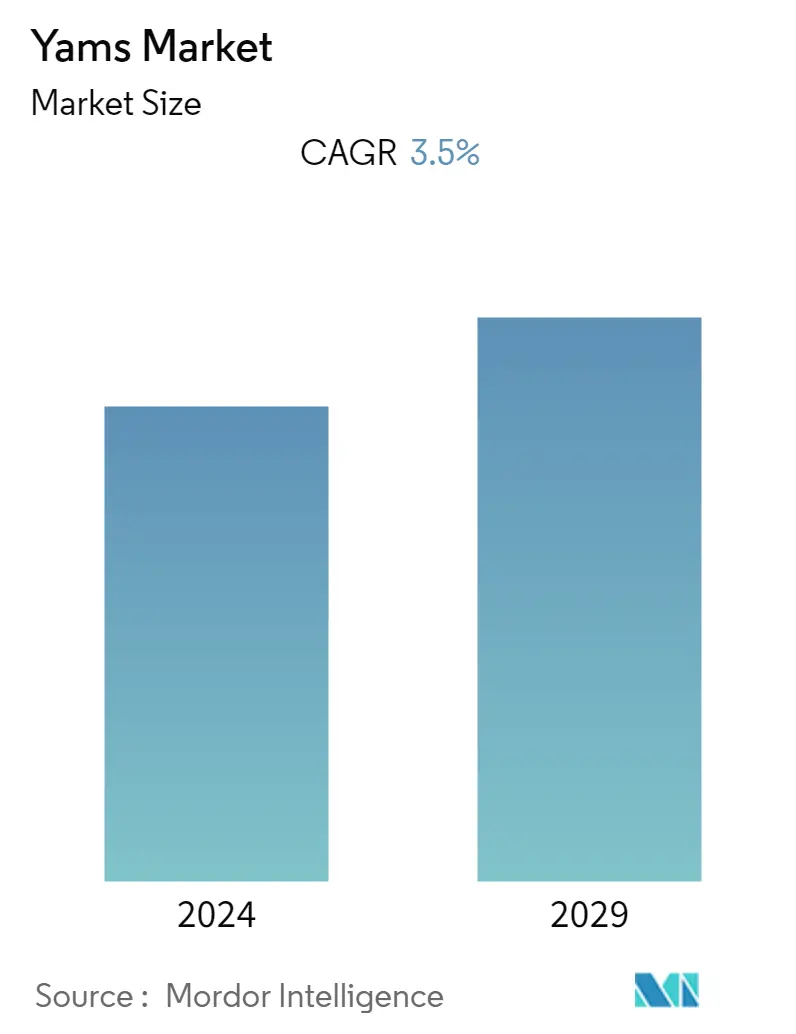Market Size of Yams Industry

| Study Period | 2019 - 2029 |
| Base Year For Estimation | 2023 |
| Forecast Data Period | 2024 - 2029 |
| CAGR | 3.50 % |
| Fastest Growing Market | South America |
| Largest Market | Africa |
Major Players*Disclaimer: Major Players sorted in no particular order |
Yams Market Analysis
The Yams market is projected to register a CAGR of 3.5% over the forecast period.
- Yams are starchy staples in the form of large tubers produced by annual and perennial vines grown in Africa, the United States, the Caribbean, South Pacific, and Asia. White Guinea yam, D. rotundata, is the most critical species in western and Central Africa. Water yam, D. alata, the second most cultivated species, originated from Asia and is the most widely distributed species in the world. Consumers' demand for yam is generally very high globally, and yam cultivation is profitable despite high production costs. Yam processors are reluctant to invest in new processing capacity without a steady supply of high-quality tubers.
- The increasing awareness among consumers of yams' health benefits increases global demand. Yams are nutrient-rich and contain vitamin C, magnesium, potassium, manganese, copper, and fiber. Yams also help in improving brain functions and relieving arthritis symptoms. They contain a unique compound called diosgenin, which promotes neuron growth, enhances brain function, and inhibits the progression of both osteoporosis arthritis and rheumatoid arthritis. Yams also help to maintain cholesterol levels.
- Yam tubers comprise about 21% dietary fiber and are rich in carbohydrates, vitamin C, and essential minerals. Worldwide annual consumption of yams is 18 million tons, with 15 million in West Africa in 2021. Annual consumption in West Africa is 61 kilograms per capita in the year 2021. Yams are boiled, roasted, baked, or fried. In Africa, they are also mashed into a sticky paste or dough after boiling.
Yams Industry Segmentation
Yams are perennial herbaceous vines cultivated for the consumption of their starchy tubers in many temperate and tropical regions, especially in West Africa, South America and the Caribbean, Asia, and Oceania.
The yams market is segmented by geography into North America, Europe, Asia-Pacific, South America, and the Middle East and Africa. The report offers an analysis of production (volume), consumption (value and volume), import (value and volume), export (value and volume), and price trend analysis.
The report offers market size and forecasts in terms of value (USD thousand) and volume (metric ton) for all the above segments.
| Geography | ||||||||
| ||||||||
| ||||||||
| ||||||||
| ||||||||
|
Yams Market Size Summary
The yams market is experiencing steady growth, driven by increasing global demand for this nutrient-rich tuber. Yams, primarily cultivated in regions such as Africa, the Caribbean, and Asia, are known for their health benefits, including improved brain function and cholesterol maintenance. The market is characterized by high consumer demand and profitable cultivation, despite the challenges posed by high production costs and the need for a consistent supply of quality tubers. The market's expansion is supported by the growing awareness of yams' health benefits, which include essential vitamins and minerals that contribute to bone health, metabolism, and heart function.
In terms of production, West Africa dominates the yam market, with countries like Nigeria and Ghana leading in both production and export. The region's historical significance in yam cultivation, dating back thousands of years, has established it as a primary commodity. However, challenges such as declining soil fertility and pest pressures are prompting farmers to adopt advanced agricultural techniques to maintain productivity. The global export market is also expanding, with countries like Ghana, the United States, and Jamaica being major exporters. The increased demand for yams is expected to further enhance export opportunities, particularly to markets in the United Kingdom and the United States.
Yams Market Size - Table of Contents
-
1. MARKET DYNAMICS
-
1.1 Market Overview
-
1.2 Market Drivers
-
1.3 Market Restraints
-
1.4 Value Chain Analysis
-
-
2. MARKET SEGMENTATION (Production Analysis in Volume, Consumption Analysis by Volume and Value, Import Analysis by Value and Volume, Export Analysis by Value and Volume, and Price Trend Analysis)
-
2.1 Geography
-
2.1.1 North America
-
2.1.1.1 United States
-
2.1.1.2 Canada
-
2.1.1.3 Mexico
-
2.1.1.4 Rest of North America
-
-
2.1.2 Europe
-
2.1.2.1 Germany
-
2.1.2.2 United Kingdom
-
2.1.2.3 France
-
2.1.2.4 Russia
-
2.1.2.5 Spain
-
2.1.2.6 Rest of Europe
-
-
2.1.3 Asia Pacific
-
2.1.3.1 India
-
2.1.3.2 China
-
2.1.3.3 Japan
-
2.1.3.4 Rest of Asia Pacific
-
-
2.1.4 South America
-
2.1.4.1 Brazil
-
2.1.4.2 Argentina
-
2.1.4.3 Rest of South America
-
-
2.1.5 Middle East and Africa
-
2.1.5.1 Nigeria
-
2.1.5.2 Ghana
-
2.1.5.3 Rest of Middle East and Africa
-
-
-
Yams Market Size FAQs
What is the current Yams Market size?
The Yams Market is projected to register a CAGR of 3.5% during the forecast period (2024-2029)
Which is the fastest growing region in Yams Market?
South America is estimated to grow at the highest CAGR over the forecast period (2024-2029).

